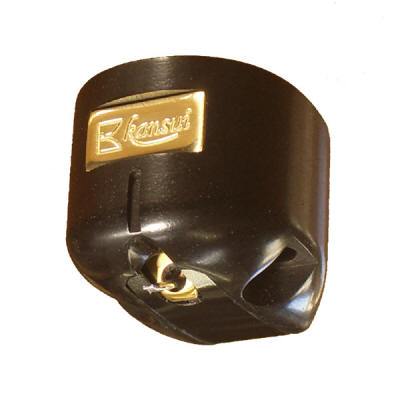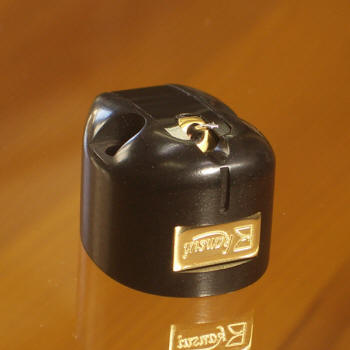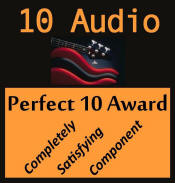In my November, 2008 review of the Miyajima Shilabe phono cartridge, I concluded with “The Miyajima Shilabe phono cartridge is closer to perfection than any cartridge I have previously experienced. It may be possible to surpass its outstanding performance, perhaps with a “Shilabe mk. 2”. Until then, I am … a devoted fan.” And a devoted fan I have been since before that review was posted.

The Shilabe review is a good place to start as we take a close look, and listen, to Noriyuki Miyajima’s latest phono cartridge, the $3600 Kansui. Kansui is a Japanese word meaning “achieved an aim”. The aim, apparently, was to surpass the performance of the $2800 Shilabe, and judging by the results, Miyajima-san set a goal of not simply improving the already excellent sound qualities of the Shilabe, but taking his Cross Ring technology to the next level. In many other moving coil cartridges, the coils are at the far end of the cantilever. Imagine a see-saw. The stylus is at one end and the coils are at the other. As the stylus moves up, the coils move down. With the Cross Ring method, the moving coils are located at the fulcrum, or pivot point, of the cantilever where the signal would suffer the least distortion. There is nothing “hanging off the other end” where mass, inertia, or flexing materials affect the fragile microvolt signal to a greater degree.
Microvolt, as in millionths of a volt? You might think that because the cartridge is rated at .23 millivolts that the signal is measured in thousandths of a Volt. You would be wrong, mostly. Sure, the maximum levels are in the millivolt range, but the much smaller sounds which give you the nuance of a recording, the ambiance, the character of a voice, and other almost subliminal clues about the art of music are in the much tinier signals, which can, indeed, be measured in the millionths of a Volt. If a cartridge harms or distorts these sounds, regardless of how pleasant that distortion might be, it is not re-producing your music correctly. Now you know.
The Kansui, like the Shilabe, is rated at .23mV output and weights 10.4g, with a DCR of “about 16 Ohms”. The Kansui seemed to require more playing time to break in and is more sensitive to setting the VTA precisely for optimal performance. The usual routine of finding the best vertical tracking angle by raising and lowering the rear of the tonearm incrementally gives good results. A Fozgometer is on order but was not available in time to verify the settings I had reached by ear.* I had requested that the review cartridge be equipped with threaded mounting holes, instead of having to use long mounting bolts pointing upwards as with the Shilabe. I hope that the fixed nuts become a standard feature of the Kansui as they made mounting and adjusting the cartridge much easier. On the other hand, it is not much of an issue for a task that you might only perform once for the rest of your life. But I am getting ahead of myself.
Let’s talk about reviews. Not just the ones you might read and that reviewers write: the process of a review or evaluation. We use our experience and judgment. We have some form of a process or procedure for working through the variables of equipment setup and system matching. We listen a whole bunch to music we like or are familiar with to provide an acceptably reliable basis for the conclusions we reach. (I can use terms like “whole bunch” because the editor is a really nice guy.) Then, within the context of our experience, equipment, and other variables, the conclusions are valid. The key word is “variables”. A critical variable for the purposes of evaluating a music reproduction system is relating what we hear to some standard of excellence, preferably live music.
Last night, partially to test the validity of the conclusions below, I went to Denver’s Boettcher Concert Hall to hear the Colorado Symphony Orchestra. There were two specific sonic characteristics I intently focused on: the treble range and the sense of openness and purity of tone, and the way harmonics are produced when the fundamental note is in the lower midrange around middle C (262 Hz). Then, after about a 45 minute interval to drive back home, I listened to the Kansui installed in a system which includes a SOTA Cosmos IV turntable with Triplanar VII tonearm, Bob’s Devices CineMag Step Up Transformers, Levinson no. 326S preamplifier with internal phono stage, Levinson no. 532H power amplifier, and YG Acoustics Kipod Main Modules speakers, augmented in the bass with a pair of Gallo TR-3 subwoofers.
The main reason for waiting for the concert date to write this review was that the Kansui was either so pleasantly unreal that it skewed my reaction to music, or it was a true breakthrough in performance, raising the bar for the entire component class of moving coil phono cartridges. For over two years, I had been listening to one of the best cartridges on the planet, so a new cartridge would have to offer a genuine paradigm shift to be an actual improvement.
The Kansui accurately reproduces the entire treble range, not so much cleaning the window through which we listen to recorded music, but removing the window and demolishing the wall in which it was installed. The tactile clarity of the information that the Kansui transmits to the preamplifier is similar to listening to a master tape. The Kansui enables the listener to seemingly hear through the entire LP process and connect with the original performance in a manner unlike that which other cartridges can manage. In Sting’s “Rock Steady” on the Nothing Like the Sun double LP, someone says, “Got any more bright ideas?” I have heard this cut many, many times, but I heard that voice with the Kansui and, to be honest with you, for a brief moment I was afraid that there was a stranger in the room with me. Heartbeat rising, my head snapped to the far left, wide eyed. A mere second or two later, I felt relief that no one was really there. This feeling of presence has never before been so compelling – or startling! On the same Sting LP, when he sings “ooh, ooh, ooh, ooh” at the end of “The Secret Marriage”, his presence in the room was so strongly felt that I thought I should offer him a beer.

The Kansui has a bit less leading edge impact than the Shilabe, although the sound in the succeeding milliseconds has a bit more body and depth. This is one of the areas that improves with more break-in time: at 100 hours the cartridge is just starting to sound close to its final character. There is greater separation of musicians on the performance stage with the Kansui, while retaining the characteristic body and depth of individual performers that makes the Shilabe so entertaining. The most noticeable difference between the two Miyajima cartridges is in the upper frequencies, where the new Kansui sets a new standard of excellence.
The Kansui offers improvements in the areas of overall resolution and upper frequency purity resulting in greater listener involvement in every performance. The lower frequencies also show an easier ability to follow bass instruments, whether cello, timpani, or electric bass guitar. Voices in the midrange, both male and female, have a rich and deeply resonant quality and can sound very beautiful.
The Kansui has greater resolution than the already outstanding Shilabe. Not only is more information retrieved from the vinyl groove on all LPs. The coherence and solidity of the sound stage is noticeably improved, endowing each and every performer with more individuality, more charm. The supreme resolution in the upper frequencies offers a character that is the very essence of sweetness and light. Importantly, the entire presentation is lacking any harshness, glare, grain or any forwardness that even hints at problems anywhere in the audible frequency range. The result is to move one giant step closer to the sound of live music. No, we are not (quite) there yet, but at this level of artificial reality, the Kansui offers a reasonable alternative to the enjoyment, not to mention the logistical effort and expense, of attending a concert.
The Kansui has created a problem, one that could take hundreds of hours of my time to resolve. In this new era of digital music servers, I have recorded many of my favorite LPs using the Shilabe cartridge. In fact, the recording/conversion process waited for a cartridge good enough to make the effort worthwhile. After the arrival of the Shilabe, the LP Conversion Project was full steam ahead. Now, decisions will be made to re-record some number of the LPs with the higher performing Kansui phono cartridge. No regrets, as the Shilabe recordings, all at 24 bit 192k resolution, sound very fine, indeed. Early results with the Kansui at the head of the recording chain are even better.
I wish that everyone who enjoys music could hear this cartridge. It has given me a greater appreciation for the musicality of the LP medium. It is a humbling experience to have previous standards and expectations destroyed by a new component. The Miyajima Kansui raises the bar for moving coil phono cartridge performance and is a “must hear” before purchasing any new cartridge, regardless of price. Thank you, Miyajima-san, for my new reference phono cartridge. You have indeed “achieved an aim”.
Overall Rating: 10 LPs

Link to manufacturer’s Web site: Miyajima Laboratory
Link to US Distributor: Robyatt Audio Products
* The azimuth was subsequently checked with a Fozgometer and found to be optimal with the top of the headshell perfectly level. No further adjustment was necessary.
